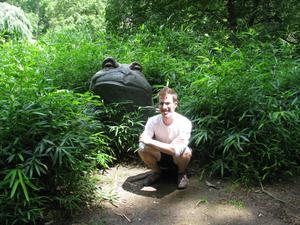NU Splash Biography
Edit this biography!DANIEL LYNCH, NU PhD candidate studying legged robot locomotion
|
College: Northwestern University Major: Mechanical Engineering Year of Graduation: G |

|
Brief Biographical Sketch:
I'm a mechanical engineering PhD candidate at Northwestern, and I research ways to enable legged robots to walk and run on challenging surfaces like sand, dirt, gravel, and Martian regolith. In my spare time, I enjoy writing music, working out, and exploring the outdoors, both on land and on/in the water. Past Classes(Clicking a class title will bring you to the course's section of the corresponding course catalog)M642: The Mathematics of Modern Musical Harmony in Splash Spring 2023 (May. 27, 2023)
Was legendary jazz saxophonist John Coltrane secretly a mathematician? When people talk about the mathematical beauty of music, Bach is among the most-mentioned classical composers, but Coltrane pushed musical harmony miles beyond anything Bach and his contemporaries did, and the methods he used to get there have a surprisingly elegant mathematical foundation: graph theory, which has a wide array of applications, including social network analysis and robot navigation. In this class, we’ll navigate a mathematical and musical journey together as we develop tools to analyze examples of musical harmony from a diverse range of genres. Along the way, we’ll sight-see a bit and look at some other features and uses of graph theory, and, time permitting, we’ll even see how to use this framework to “solve” for chord progressions that work with a given melody. I look forward to sharing this mathematical and musical journey with you!
M591: Rabbits and Foxes, Butterflies and Tornadoes, and Chaos in Splash 2022 (Apr. 02, 2022)
What do rabbits, foxes, butterflies, and tornadoes all have in common? Their behavior, in one way or another, can be described with math and can be simulated and (sometimes) predicted with computer programs.
We'll start simple, with the definition of the derivative, and then we'll turn this definition on its head to see how to simulate several increasingly complex systems, including a predator-prey model of population dynamics (rabbits and foxes) and even a simple model of weather that gave rise to the so-called "butterfly effect" - a concept in chaos theory that claims a butterfly flapping its wings in Brazil can cause a tornado in Texas.
As we explore this mathematical zoo together, we'll let the computer do the heavy lifting and instead use our brains to develop some intuition for what's going on. We'll use one of the most in-demand programming languages today--Python--along with the same simulation techniques as those used to plan the Apollo missions to the Moon.
I hope you'll leave this course feeling excited about how you can use math and programming to understand and (sometimes!) predict complex and ever-changing real-world processes.
|
|
